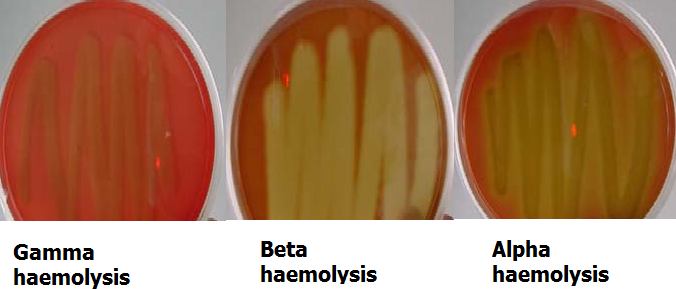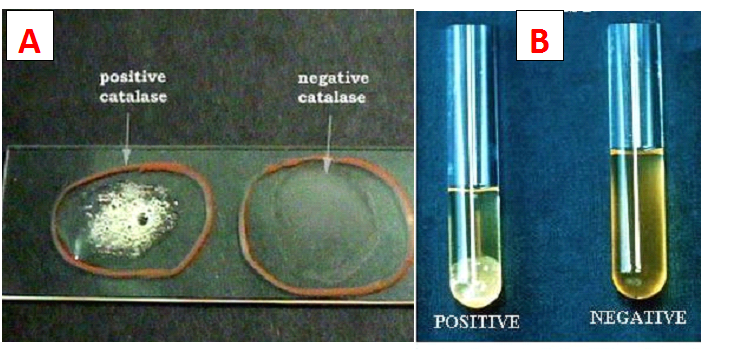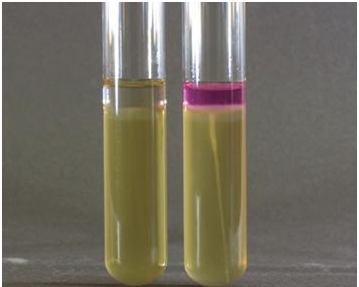Blood agar haemolysis is used to determine the haemolytic ability of some pathogenic microorganisms including Streptococcus pneumoniae, Staphylococcus aureus and Micrococcus species. Some pathogenic bacteria are capable of expressing some specific exotoxins known as haemolysin – which reacts as antibodies homologous to the surface antigens of red blood cells (erythrocytes).
This phenomenon allows these organisms the exceptional ability to lyse erythrocytes in blood culture media, and this can serve as basis for their identification in the microbiology laboratory. Pathogenic microorganisms produce three (3) different types of haemolysis on blood agar culture media: alpha (α) haemolysis, beta (β) haemolysis and gamma (γ) haemolysis (Figure 1).
Alpha haemolysis is a partial lysis of red blood cells (RBCs), and this is seen in the cultures of Streptococcus mitis and pneumoniae which both show a green-opaque colony on blood agar plates. Beta haemolysis is a complete lysis of RBCs, and it is mostly seen with cultures of Streptococcus pyogenes, Staphylococcus aureus and Streptococcus agalactiae.
In β-haemolysis, a clear zone normally surrounds the bacterial colony. Gamma haemolysis produces no clear-cut lysis of RBCs, and the bacterial colonies are normal-looking colonies because no haemolysis occurred. Micrococcus species and Staphylococcus epidermidis are typical examples of γ-haemolytic bacteria.

PROCEDURE FOR BLOOD AGAR HAEMOLYSIS TEST
- Blood agar haemolysis test is carried out on nutrient agar modified by the incorporation of 5 % oxalated or defribinated blood (from horse, sheep, and rabbit or ox blood) and 1 % sodium chloride.
- Prepare and sterilize nutrient agar medium according to the manufacturer’s instructions.
- After sterilization, liquefy agar medium by warming in a water bath at 50oC.
- Add 0.5-10 ml of defribinated blood to the nutrient agar media and mix thoroughly by rotation or inversion of the flask containing the prepared medium.
- Aseptically pour sterile blood agar medium into Petri dish(s), and allow on the workbench to solidify.
- Aseptically inoculate the test bacteria on the prepared blood agar plate and incubate plate(s) at 37oC for 18-24 hrs.
- Observe plate(s) for the presence of haemolysis (α, β, or γ).
References
Basic laboratory procedures in clinical bacteriology. World Health Organization (WHO), 1991. Available from WHO publications, 1211 Geneva, 27-Switzerland.
Beers M.H., Porter R.S., Jones T.V., Kaplan J.L and Berkwits M (2006). The Merck Manual of Diagnosis and Therapy. Eighteenth edition. Merck & Co., Inc, USA.
Biosafety in Microbiological and Biomedical Laboratories. 5th edition. U.S Department of Health and Human Services. Public Health Service. Center for Disease Control and Prevention. National Institute of Health. HHS Publication No. (CDC) 21-1112.2009.
Cheesbrough M (2010). District Laboratory Practice in Tropical Countries. Part I. 2nd edition. Cambridge University Press, UK.
Cheesbrough M (2010). District Laboratory Practice in Tropical Countries. Part 2. 2nd edition. Cambridge University Press, UK.
Collins C.H, Lyne P.M, Grange J.M and Falkinham J.O (2004). Collins and Lyne’s Microbiological Methods. Eight edition. Arnold publishers, New York, USA.
Disinfection and Sterilization. (1993). Laboratory Biosafety Manual (2nd ed., pp. 60-70). Geneva: WHO.
Garcia L.S (2010). Clinical Microbiology Procedures Handbook. Third edition. American Society of Microbiology Press, USA.
Garcia L.S (2014). Clinical Laboratory Management. First edition. American Society of Microbiology Press, USA.
Fleming, D. O., Richardson, J. H., Tulis, J. I. and Vesley, D. (eds) (1995). Laboratory Safety: Principles and practice. Washington DC: ASM press.
Dubey, R. C. and Maheshwari, D. K. (2004). Practical Microbiology. S.Chand and Company LTD, New Delhi, India.
Gillespie S.H and Bamford K.B (2012). Medical Microbiology and Infection at a glance. 4th edition. Wiley-Blackwell Publishers, UK.
Discover more from Microbiology Class
Subscribe to get the latest posts sent to your email.




